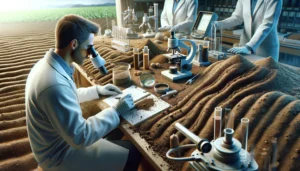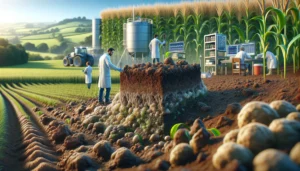Comprehensive Guide to Tilth and Soil Science in Europe
Tilth and soil health are fundamental to successful and sustainable farming in Europe. With diverse soil types, climates, and farming practices across the continent, managing soil health is both a challenge and an opportunity for European farmers. This guide provides an in-depth look at the concepts of tilth and soil health, offering practical tips, expert advice, and sustainable practices to help farmers optimize their soil management strategies.
Understanding Tilth and Soil Science
What is Tilth?
Tilth refers to the physical condition of soil in relation to its suitability for planting and growing crops. Good tilth is characterized by soil that is loose, crumbly, and well-aerated, allowing for easy root penetration and water infiltration. Factors influencing tilth include soil texture, structure, organic matter content, moisture levels, and compaction.
What is Soil Health?
Soil Health is the capacity of soil to function as a living ecosystem that sustains plants, animals, and humans. Healthy soil provides essential ecosystem services such as nutrient cycling, water filtration, carbon sequestration, and habitat for organisms. Key indicators of soil health include soil organic matter, soil structure, microbial activity, nutrient availability, and pH levels.
Importance of Tilth and Soil Science
- Enhanced Crop Productivity: Good tilth and healthy soil provide optimal growing conditions for crops, leading to higher yields and better quality produce.
- Water Management: Well-structured soil with good tilth improves water infiltration and retention, reducing the risk of drought stress and soil erosion.
- Nutrient Cycling: Healthy soil with active microbial populations efficiently cycles nutrients, ensuring their availability to plants.
- Carbon Sequestration: Healthy soils can sequester significant amounts of carbon, mitigating climate change by reducing atmospheric CO2 levels.
- Biodiversity: Soils with good tilth and health support diverse biological communities, which contribute to ecosystem stability and resilience.
Soil Types and Regions in Europe
Common Soil Types
- Chernozem: Rich, black soils found in Eastern Europe, known for high fertility and organic matter content.
- Podzol: Acidic soils common in Northern Europe, characterized by leached layers and lower fertility.
- Alfisol: Moderately leached soils with a high base saturation, found in Central Europe, suitable for agriculture.
- Clayey Soils: Heavy soils found in regions like the UK and the Netherlands, known for high nutrient content but poor drainage.
- Sandy Soils: Light soils with good drainage but low nutrient retention, common in coastal areas.
Regional Variations
- Mediterranean Region: Characterized by calcareous and alluvial soils, with challenges related to salinity and water availability.
- Northern Europe: Dominated by podzolic and peaty soils, with issues related to acidity and drainage.
- Eastern Europe: Known for fertile chernozem soils, with high agricultural potential.
- Central Europe: Diverse soil types including alfisols and loams, supporting a range of agricultural activities.
- Western Europe: Includes a mix of clayey and loamy soils, with advanced agricultural practices and infrastructure.
Soil Health Management Practices
Soil Testing and Analysis
- Regular Soil Testing: Conduct regular soil tests to monitor pH, nutrient levels, and organic matter content. Soil testing helps identify deficiencies and guide fertilization and amendment practices.
- Visual Soil Assessment: Perform visual assessments to evaluate soil structure, compaction, and biological activity. Look for indicators such as soil color, texture, and presence of earthworms.
Organic Matter Management
- Composting: Apply compost to increase soil organic matter, improve soil structure, and enhance nutrient availability.
- Green Manure: Grow cover crops such as clover or rye and incorporate them into the soil to add organic matter and improve soil fertility.
- Mulching: Use organic mulches like straw or wood chips to protect soil, retain moisture, and add organic matter as they decompose.
Crop Rotation and Diversification
- Crop Rotation: Rotate crops to prevent soil depletion, reduce pest and disease buildup, and improve soil structure.
- Diversified Cropping Systems: Integrate a variety of crops to promote biodiversity and improve resilience to pests and diseases.
Reduced Tillage and Conservation Tillage
- No-Till Farming: Avoid soil disturbance to preserve soil structure, reduce erosion, and enhance microbial activity.
- Conservation Tillage: Use minimum tillage practices to reduce soil disturbance while maintaining soil cover and structure.
Soil Amendments
- Lime: Apply lime to raise soil pH in acidic soils, improving nutrient availability and microbial activity.
- Gypsum: Use gypsum to improve soil structure, particularly in clayey soils, and add calcium and sulfur.
- Biochar: Incorporate biochar to improve soil structure, increase water retention, and enhance microbial activity.
Water Management
- Efficient Irrigation: Use efficient irrigation methods such as drip or micro-sprinklers to reduce water use and ensure precise water delivery to crops.
- Rainwater Harvesting: Collect and store rainwater for irrigation to reduce reliance on external water sources.
- Mulching: Apply mulch to retain soil moisture, reduce evaporation, and suppress weeds.
Biodiversity Enhancement
- Agroforestry: Integrate trees and shrubs into agricultural landscapes to enhance biodiversity, improve soil health, and provide additional income sources.
- Hedgerows and Buffer Strips: Plant hedgerows and buffer strips to provide habitat for wildlife, reduce erosion, and capture runoff.
- Polyculture: Grow multiple crops in the same space to promote biodiversity and resilience to pests and diseases.
Integrated Pest Management (IPM)
- Biological Controls: Utilize natural predators and beneficial insects to control pest populations.
- Cultural Practices: Implement crop rotation, intercropping, and planting resistant varieties to manage pests and diseases.
- Mechanical Controls: Use physical methods such as traps, barriers, and hand-picking to reduce pest numbers.
Renewable Energy and Sustainable Practices
- Solar Power: Install solar panels to generate electricity for farm operations, reducing reliance on fossil fuels.
- Wind Turbines: Use small wind turbines to harness wind energy, providing an additional renewable energy source.
- Bioenergy: Convert agricultural waste into bioenergy through anaerobic digestion or biomass combustion.
Practical Tips for Improving Soil Health and Tilth
Soil Health Monitoring
- Regular Soil Testing: Conduct regular soil tests to monitor pH, nutrient levels, and organic matter content. Soil testing helps identify deficiencies and guide fertilization and amendment practices.
- Visual Soil Assessment: Perform visual assessments to evaluate soil structure, compaction, and biological activity. Look for indicators such as soil color, texture, and presence of earthworms.
Organic Matter Management
- Composting: Apply compost to increase soil organic matter, improve soil structure, and enhance nutrient availability.
- Green Manure: Grow cover crops such as clover or rye and incorporate them into the soil to add organic matter and improve soil fertility.
- Mulching: Use organic mulches like straw or wood chips to protect soil, retain moisture, and add organic matter as they decompose.
Crop Rotation and Diversification
- Crop Rotation: Rotate crops to prevent soil depletion, reduce pest and disease buildup, and improve soil structure.
- Diversified Cropping Systems: Integrate a variety of crops to promote biodiversity and improve resilience to pests and diseases.
Reduced Tillage and Conservation Tillage
- No-Till Farming: Avoid soil disturbance to preserve soil structure, reduce erosion, and enhance microbial activity.
- Conservation Tillage: Use minimum tillage practices to reduce soil disturbance while maintaining soil cover and structure.
Soil Amendments
- Lime: Apply lime to raise soil pH in acidic soils, improving nutrient availability and microbial activity.
- Gypsum: Use gypsum to improve soil structure, particularly in clayey soils, and add calcium and sulfur.
- Biochar: Incorporate biochar to improve soil structure, increase water retention, and enhance microbial activity.
Water Management
- Efficient Irrigation: Use efficient irrigation methods such as drip or micro-sprinklers to reduce water use and ensure precise water delivery to crops.
- Rainwater Harvesting: Collect and store rainwater for irrigation to reduce reliance on external water sources.
- Mulching: Apply mulch to retain soil moisture, reduce evaporation, and suppress weeds.
Biodiversity Enhancement
- Agroforestry: Integrate trees and shrubs into agricultural landscapes to enhance biodiversity, improve soil health, and provide additional income sources.
- Hedgerows and Buffer Strips: Plant hedgerows and buffer strips to provide habitat for wildlife, reduce erosion, and capture runoff.
- Polyculture: Grow multiple crops in the same space to promote biodiversity and resilience to pests and diseases.
Integrated Pest Management (IPM)
- Biological Controls: Utilize natural predators and beneficial insects to control pest populations.
- Cultural Practices: Implement crop rotation, intercropping, and planting resistant varieties to manage pests and diseases.
- Mechanical Controls: Use physical methods such as traps, barriers, and hand-picking to reduce pest numbers.
Renewable Energy and Sustainable Practices
- Solar Power: Install solar panels to generate electricity for farm operations, reducing reliance on fossil fuels.
- Wind Turbines: Use small wind turbines to harness wind energy, providing an additional renewable energy source.
- Bioenergy: Convert agricultural waste into bioenergy through anaerobic digestion or biomass combustion.
Case Studies and Examples
Case Study 1: Regenerative Agriculture in Spain
Location: Andalusia, Spain
Practices:
- Cover Cropping: Using cover crops like clover and rye to improve soil organic matter and prevent erosion.
- No-Till Farming: Adopting no-till practices to maintain soil structure and enhance microbial activity.
- Agroforestry: Integrating olive trees with arable crops to diversify income and improve biodiversity.
Outcomes: The farm has seen improved soil health, increased crop yields, and enhanced resilience to climate change through regenerative practices.
Case Study 2: Sustainable Viticulture in France
Location: Bordeaux, France
Practices:
- Composting: Applying compost to vineyards to improve soil fertility and structure.
- Organic Amendments: Using organic amendments like bone meal and green manure to enhance soil health.
- Water Management: Implementing efficient drip irrigation systems to conserve water.
Outcomes: The vineyard has achieved high-quality grape production, improved soil health, and reduced environmental impact through sustainable viticulture practices.
Case Study 3: Biodynamic Farming in Germany
Location: Bavaria, Germany
Practices:
- Biodynamic Preparations: Using biodynamic preparations to enhance soil fertility and plant health.
- Crop Rotation: Implementing diverse crop rotations to improve soil structure and reduce pest pressure.
- Hedgerows and Buffer Strips: Planting hedgerows to provide wildlife habitat and reduce soil erosion.
Outcomes: The farm has achieved healthy soil, diverse ecosystems, and high-quality produce through biodynamic farming practices.
Case Study 4: Precision Agriculture in the Netherlands
Location: Flevoland, Netherlands
Practices:
- Precision Irrigation: Using soil moisture sensors and automated irrigation systems to optimize water use.
- Soil Mapping: Creating detailed soil maps using GIS technology to guide soil management decisions.
- Variable Rate Technology (VRT): Applying fertilizers and pesticides at variable rates based on soil and crop needs.
Outcomes: The farm has improved resource use efficiency, increased crop yields, and enhanced soil health through precision agriculture practices.
Challenges and Solutions
Soil Degradation
Challenges:
- Erosion: Soil erosion caused by wind and water can degrade soil structure and reduce fertility.
- Compaction: Heavy machinery and intensive farming practices can lead to soil compaction, restricting root growth and water infiltration.
Solutions:
- Cover Cropping: Plant cover crops to protect soil from erosion and improve soil structure.
- Reduced Tillage: Minimize soil disturbance to prevent compaction and maintain soil health.
- Organic Matter Addition: Apply compost and organic mulches to improve soil structure and fertility.
Climate Change
Challenges:
- Extreme Weather: Increased frequency of extreme weather events, such as droughts and floods, can impact soil health and crop productivity.
- Temperature Fluctuations: Changes in temperature patterns can affect soil microbial activity and nutrient availability.
Solutions:
- Water Conservation: Implement efficient irrigation systems and water conservation practices to manage water resources.
- Soil Resilience: Enhance soil resilience through practices like cover cropping, crop rotation, and organic matter addition.
- Climate-Smart Agriculture: Adopt climate-smart agricultural practices to mitigate the impacts of climate change on soil health.
Nutrient Management
Challenges:
- Nutrient Depletion: Intensive farming can deplete essential nutrients from the soil, affecting crop yields.
- Nutrient Runoff: Excessive use of fertilizers can lead to nutrient runoff, polluting water bodies and degrading soil health.
Solutions:
- Soil Testing: Conduct regular soil tests to monitor nutrient levels and guide fertilization practices.
- Organic Fertilizers: Use organic fertilizers like compost and manure to enhance soil fertility and reduce nutrient runoff.
- Precision Application: Apply fertilizers and amendments precisely based on soil and crop needs to minimize waste and environmental impact.
Soil Biodiversity
Challenges:
- Loss of Soil Organisms: Intensive farming and chemical use can reduce soil biodiversity, affecting soil health and ecosystem functions.
- Soil Health Decline: Declining soil biodiversity can lead to reduced nutrient cycling, poor soil structure, and increased pest pressure.
Solutions:
- Biodiversity Enhancement: Implement practices like agroforestry, polyculture, and hedgerow planting to enhance soil biodiversity.
- Reduced Chemical Use: Minimize the use of synthetic chemicals to protect soil organisms and promote a healthy soil ecosystem.
- Organic Matter Management: Add organic matter to support soil microbial activity and improve soil health.
Future Outlook for Soil Health in Europe
Technological Advancements
- Soil Sensors and IoT: Advanced soil sensors and Internet of Things (IoT) devices provide real-time data on soil moisture, nutrient levels, and microbial activity, enabling precise soil management.
- Drones and GIS: Drones equipped with multispectral cameras and GIS technology offer detailed soil mapping and monitoring capabilities, enhancing decision-making.
- Artificial Intelligence: AI-powered tools analyze soil data to provide insights and recommendations for optimizing soil health and crop productivity.
Policy and Support
- Government Initiatives: European governments are implementing policies and support programs to promote sustainable soil management and conservation practices.
- EU Green Deal: The European Green Deal aims to make Europe the first climate-neutral continent by 2050, with significant focus on sustainable agriculture and soil health.
- Funding Opportunities: Farmers can access funding opportunities through programs like the Common Agricultural Policy (CAP) and Horizon Europe for soil health initiatives.
Research and Innovation
- Soil Health Research: Ongoing research focuses on understanding soil health dynamics, developing innovative soil management practices, and addressing emerging challenges.
- Collaborative Projects: Collaborative projects involving universities, research institutions, and farmers aim to develop and implement sustainable soil management solutions.
- Knowledge Exchange: Platforms for knowledge exchange and dissemination of best practices help farmers adopt innovative soil health practices.
Sustainable Practices
- Regenerative Agriculture: Emphasis on regenerative agriculture practices that restore soil health, enhance biodiversity, and improve resilience to climate change.
- Organic Farming: Increasing adoption of organic farming practices that prioritize soil health and environmental sustainability.
- Agroecology: Integrating agroecological principles to create sustainable and resilient farming systems that prioritize soil health and ecosystem functions.
Conclusion
Tilth and soil health are fundamental to the sustainability and productivity of agriculture in Europe. By adopting comprehensive soil health management practices, farmers can enhance soil structure, improve crop yields, and contribute to environmental sustainability. This guide provides valuable insights, practical tips, and strategies for optimizing soil health and tilth, ensuring long-term agricultural success and resilience. Through continued innovation, research, and collaboration, European farmers can lead the way in sustainable soil management and contribute to a healthier, more sustainable future for agriculture.
Tilth and Soil Science Gallery














